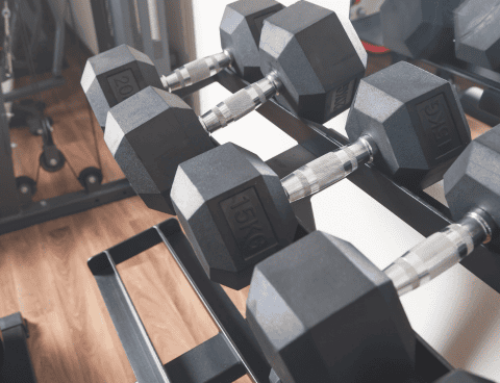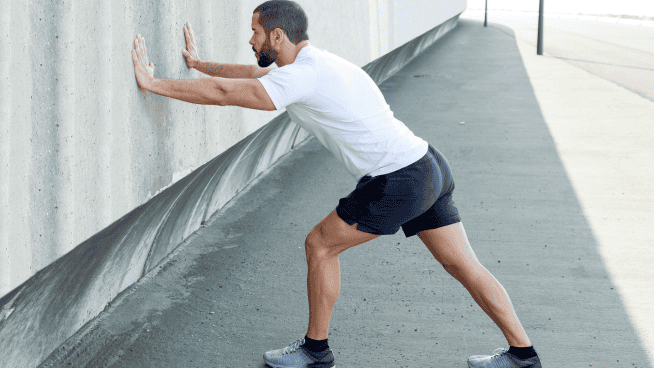In-Season Football Workouts to Stay Strong, Fast and Healthy
A football player who stops training in-season can potentially lose 20 to 25 percent percent of the strength he gained during off-season training. This can mean an increased risk of injury as well as the loss of speed, power and stamina.
Here’s a workout to keep you strong, explosive and injury-free during the season.
In football the most commonly injured areas of the body are the knees, ankles and shoulders, so exercise selection emphasizes those areas. The focus is on building/maintaining strength, speed and power and preventing injury with the use of tempo-control, isolateral exercises, mobility drills, soft-tissue modalities and training the central nervous system.
I use exercises that are very familiar to athletes, so you can choose weights at or near your rep max in order to properly stimulate your muscles. One big mistake you often see athletes make during in-season training is choosing a light weight and simply going through the motions.
Throughout this program, you will see the use of isomiometric holds to influence time-under-tension with the muscle. This is good for building strength and helping to maintain positive joint integrity.
RELATED: 15 Best Football Exercises Taken Straight From the NFL
Strength Training
1A) Isomiometric Bulgarian Squats
Bulgarian Squats train the legs in an isolateral manner and have more intense balance and propioceptive aspects than traditional squats.
Sets/Reps: 4×8
[youtube video=”VmHy2RyQ1vc” /]1B) Isometric Chin-Ups
In addition to being great for upper body strength, Chin-Ups also train grip strength and can help to protect your shoulders from injury.
Sets/Reps: 4×8
[youtube video=”PBezC5MXiFY” /]2A) Lateral Lunge
In football you have to move laterally at some point, but a lot of training programs neglect training in the frontal plane. We make sure to hit it after our primary lower-body exercise.
Sets/Reps: 3×10
[youtube video=”sTV6vdXehe0″ /]2B) Neutral-Grip Dumbbell Shoulder Press
Neutral Grip Shoulder Press targets the deltoids and can help protect the shoulders from injury as well as develop upper-body strength. The neutral grip lessens rotation of the humerus bone and reduces impingement on the biceps tendon, which is at risk during overhead pressing movements with a barbell.
Sets/Reps: 3×10
[youtube video=”qXCuKVdBPgY” /]3A) Isometric Hypers
Hypers do a great job of training the posterior chain, which helps protect the ACL and keeps athletes strong and fast. We sometimes superset this movement with a tempo-controlled Prone Hamstring Curl to help eccentrically train the hamstrings and reduce the potential for strains.
Sets/Reps: 4×8
[youtube video=”xNyaN3PGm4M” /]3B) Inverted Row
Inverted Rows (you can also use a Seated Row variation) are another useful upper-back exercise. I prefer the bodyweight version using straps because it forces you to engage your core to a higher degree than seated versions. The isomiometric pause is added to emphasize the scapular retraction. We sometimes pair this with a Band Pull-Apart exercise to further strengthen and protect the shoulders and upper back.
Sets/Reps: 4×8
[youtube video=”5HWFWNRbIvk” /]Learn more about in-season weight training for football.
Core and Hand Speed
During the season we place a heavy emphasis on training the core for strength and stabilization. Sample routines include Weighted Sit-Ups for 3×15 and anti-rotation exercises such as Landmine Rotations for 3×20.
Hand speed involves a variety of drills brought to us by a martial arts teacher who has worked with NFL teams, including the Green Bay Packers and Minnesota Vikings. When performing these drills, strive for maximal speed to stimulate the proper central nervous system response.
[youtube video=”Ryy49IWq4iw” /]Lower-Body Mobility Training & Soft-Tissue Therapy
This routine helps reduce tightness and promotes flexibility (key in speed development and injury prevention) in a lot of common “problem areas” that you see in athletes (e.g., the low back, hips, hamstrings and calves.) For most of these modalities we use 10-20 passes (reps) over the muscle. The manual stretches are held 10-15 seconds (pre- and post-movement) for a total of 25-30 seconds. Check out the videos below for demonstrations of different mobility training and soft-tissue therapy exercises.
[youtube video=”pZp7FVqT3Yg” /] [youtube video=”hYiscEKe3ew” /] [youtube video=”0Wf2ejW75ig” /] [youtube video=”wZOdGMwbW3g” /] [youtube video=”Xrk3h4lsteI” /] [youtube video=”fa_TcssiNq8″ /] [youtube video=”4edWuLyzU2w” /] [youtube video=”B3GayH_yRKM” /]In-season training with athletes requires a holistic approach, so in addition to the methods discussed here, sleep and nutrition are vitally important.
If you would like to exchange ideas, ask questions and view more photos and videos, please “like” TopSpeed Strength & Conditioning on Facebook and follow us on Twitter.
RELATED: Leave These Exercises Out of Your In-Season Football Workout
[cf]skyword_tracking_tag[/cf]RECOMMENDED FOR YOU
MOST POPULAR
In-Season Football Workouts to Stay Strong, Fast and Healthy
A football player who stops training in-season can potentially lose 20 to 25 percent percent of the strength he gained during off-season training. This can mean an increased risk of injury as well as the loss of speed, power and stamina.
Here’s a workout to keep you strong, explosive and injury-free during the season.
In football the most commonly injured areas of the body are the knees, ankles and shoulders, so exercise selection emphasizes those areas. The focus is on building/maintaining strength, speed and power and preventing injury with the use of tempo-control, isolateral exercises, mobility drills, soft-tissue modalities and training the central nervous system.
I use exercises that are very familiar to athletes, so you can choose weights at or near your rep max in order to properly stimulate your muscles. One big mistake you often see athletes make during in-season training is choosing a light weight and simply going through the motions.
Throughout this program, you will see the use of isomiometric holds to influence time-under-tension with the muscle. This is good for building strength and helping to maintain positive joint integrity.
RELATED: 15 Best Football Exercises Taken Straight From the NFL
Strength Training
1A) Isomiometric Bulgarian Squats
Bulgarian Squats train the legs in an isolateral manner and have more intense balance and propioceptive aspects than traditional squats.
Sets/Reps: 4×8
[youtube video=”VmHy2RyQ1vc” /]1B) Isometric Chin-Ups
In addition to being great for upper body strength, Chin-Ups also train grip strength and can help to protect your shoulders from injury.
Sets/Reps: 4×8
2A) Lateral Lunge
In football you have to move laterally at some point, but a lot of training programs neglect training in the frontal plane. We make sure to hit it after our primary lower-body exercise.
Sets/Reps: 3×10
[youtube video=”sTV6vdXehe0″ /]2B) Neutral-Grip Dumbbell Shoulder Press
Neutral Grip Shoulder Press targets the deltoids and can help protect the shoulders from injury as well as develop upper-body strength. The neutral grip lessens rotation of the humerus bone and reduces impingement on the biceps tendon, which is at risk during overhead pressing movements with a barbell.
Sets/Reps: 3×10
3A) Isometric Hypers
Hypers do a great job of training the posterior chain, which helps protect the ACL and keeps athletes strong and fast. We sometimes superset this movement with a tempo-controlled Prone Hamstring Curl to help eccentrically train the hamstrings and reduce the potential for strains.
Sets/Reps: 4×8
[youtube video=”xNyaN3PGm4M” /]3B) Inverted Row
Inverted Rows (you can also use a Seated Row variation) are another useful upper-back exercise. I prefer the bodyweight version using straps because it forces you to engage your core to a higher degree than seated versions. The isomiometric pause is added to emphasize the scapular retraction. We sometimes pair this with a Band Pull-Apart exercise to further strengthen and protect the shoulders and upper back.
Sets/Reps: 4×8
Learn more about in-season weight training for football.
Core and Hand Speed
During the season we place a heavy emphasis on training the core for strength and stabilization. Sample routines include Weighted Sit-Ups for 3×15 and anti-rotation exercises such as Landmine Rotations for 3×20.
Hand speed involves a variety of drills brought to us by a martial arts teacher who has worked with NFL teams, including the Green Bay Packers and Minnesota Vikings. When performing these drills, strive for maximal speed to stimulate the proper central nervous system response.
[youtube video=”Ryy49IWq4iw” /]Lower-Body Mobility Training & Soft-Tissue Therapy
This routine helps reduce tightness and promotes flexibility (key in speed development and injury prevention) in a lot of common “problem areas” that you see in athletes (e.g., the low back, hips, hamstrings and calves.) For most of these modalities we use 10-20 passes (reps) over the muscle. The manual stretches are held 10-15 seconds (pre- and post-movement) for a total of 25-30 seconds. Check out the videos below for demonstrations of different mobility training and soft-tissue therapy exercises.
[youtube video=”pZp7FVqT3Yg” /] [youtube video=”hYiscEKe3ew” /] [youtube video=”0Wf2ejW75ig” /] [youtube video=”wZOdGMwbW3g” /] [youtube video=”Xrk3h4lsteI” /] [youtube video=”fa_TcssiNq8″ /] [youtube video=”4edWuLyzU2w” /] [youtube video=”B3GayH_yRKM” /]In-season training with athletes requires a holistic approach, so in addition to the methods discussed here, sleep and nutrition are vitally important.
If you would like to exchange ideas, ask questions and view more photos and videos, please “like” TopSpeed Strength & Conditioning on Facebook and follow us on Twitter.
RELATED: Leave These Exercises Out of Your In-Season Football Workout
[cf]skyword_tracking_tag[/cf]









